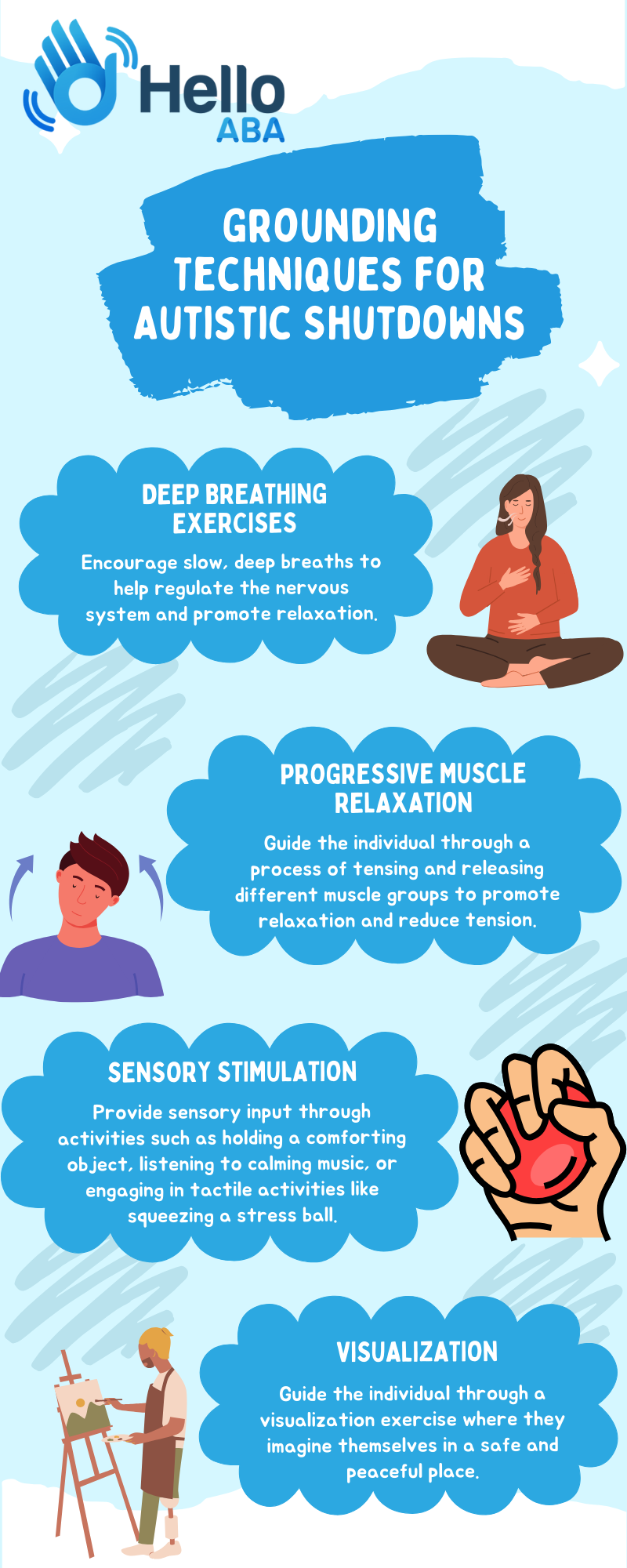Autistic shutdowns are often misunderstood and can be distressing for both the individual experiencing them and their loved ones. These episodes are not tantrums or willful defiance. In this article, we will explore the causes, symptoms, and strategies for managing shutdowns in autistic individuals.

Differentiating Shutdowns from Meltdowns
Meltdowns occur when an autistic person’s brain becomes overwhelmed with stress, resulting in an uncontrollable reaction. This reaction can manifest as outbursts. On the other hand, shutdowns are a response to sensory overwhelm and overstimulation, leading to a withdrawal or shutdown of the individual.
During an autistic shutdown, the person may exhibit physical symptoms such as sudden exhaustion, loss of coordination, slowed movement, or even a loss of communication skills. Unlike meltdowns, which are often outwardly visible, shutdowns are more internal and can be difficult to recognize from the outside.
Causes of Autistic Shutdowns
Autistic shutdowns can be triggered by various factors, with sensory overload being a common reason. The sensory sensitivities that are prevalent in individuals with autism can lead to overwhelming experiences in environments with bright lights, loud noises, or strong smells. These overwhelming sensory experiences can result in a shutdown as a protective response.
In addition to sensory overload, autistic shutdowns can occur in social situations. Difficulties in understanding and navigating the unspoken rules of conversation and social interactions can contribute to feelings of overwhelm and lead to a shutdown. It’s also important to note that autistic shutdowns can significantly interfere with the ability to complete activities of daily living.
Impact on Mental Health
Experiencing autistic shutdowns can have a significant impact on an individual’s mental health and overall well-being. These shutdowns can affect various aspects of daily living and may contribute to the development of burnout.
Effects of Shutdowns on Daily Living
Autistic shutdowns can disrupt an individual’s ability to function normally in their daily lives. During a shutdown, individuals may experience a significant reduction in their cognitive and physical abilities. Tasks that were once manageable may become overwhelming and impossible to complete. This can lead to difficulties in maintaining personal hygiene, attending school or work, and engaging in social activities.
Relationship to Burnout
Autism-related burnout is typified by reduced tolerance to stimuli, loss of skills, and persistent tiredness. Burnout is distinct from shutdowns and meltdowns in that it is a more continuous state. Long-term exposure to overpowering sensory inputs, combined with the ongoing need to hide autistic traits, are frequently the causes. The act of concealing one’s autism in an attempt to blend in is referred to as masking.

Recognizing Autistic Shutdowns
When it comes to supporting individuals with autism, it is crucial to recognize the signs of an autistic shutdown. In this section, we will explore the physical symptoms, emotional signs, and behavioral indicators that may indicate an autistic shutdown.
Physical Symptoms
Autistic shutdowns can often manifest physically, and individuals may experience various physical symptoms during these episodes. It is important to note that these physical symptoms may vary from person to person. Some common physical symptoms of an autistic shutdown include:
Physical Symptoms |
Sudden exhaustion |
Loss of coordination |
Slowed movement |
Loss of communication skills |
Feeling physically numb or dissociated |
Emotional Signs
Emotional signs can also provide valuable insight into the presence of an autistic shutdown. During a shutdown, individuals may exhibit emotional signs that indicate they are feeling overwhelmed or unable to cope with their environment. Some emotional signs of an autistic shutdown include:
Emotional Signs |
Appearing disconnected or distant |
Difficulty expressing feelings |
Unusually passive behavior |
Behavioral Indicators
Behavioral indicators can also serve as important cues when recognizing an autistic shutdown. Individuals may display specific behaviors that signal their withdrawal or need for a break. Some behavioral indicators of an autistic shutdown include:
Behavioral Indicators |
Disengaging from enjoyable activities |
Unresponsiveness to social interaction |
Disinterest in surroundings |
Seeking quiet environments |
Engaging in self-soothing behaviors, such as stimming |

Managing Autistic Shutdowns
When it comes to managing autistic shutdowns, it’s important to have strategies in place that can help support individuals during these challenging moments. Two key approaches to consider are grounding techniques and creating a safe environment.
Grounding Techniques for Autistic Shutdowns
Grounding techniques can help bring individuals out of an autistic shutdown and provide a sense of stability and connection to the present moment. These techniques focus on sensory experiences and can help redirect attention away from overwhelming thoughts or emotions. Some effective grounding techniques include:

Creating a Safe Environment
Creating a safe environment is crucial for managing autistic shutdowns. By minimizing triggers and providing a supportive space, individuals can feel more secure and have a better chance of recovering from a shutdown. Here are some strategies to consider:
- Predictability and routine: Establishing consistent routines and providing clear expectations can help reduce anxiety and minimize the likelihood of triggering a shutdown.
- Sensory considerations: Pay attention to sensory sensitivities and create an environment that accommodates individual needs. This can include providing a quiet space, using calming lighting, or reducing sensory stimuli that may be overwhelming.
- Communication support: Ensure that communication methods are accessible and understood. This may involve using visual supports, such as visual schedules or social stories, to help individuals navigate their environment and communicate their needs.
- Emotional support: Offer reassurance, patience, and understanding during and after a shutdown. Providing a non-judgmental and supportive presence can help individuals feel safe and valued.

Seeking Support and Resources
Seeking support and resources is also crucial. Whether you are a parent or caregiver of someone with autism or someone interested in learning about ASD, accessing professional guidance and community support can make a significant difference in navigating this aspect of autism.
Professional Guidance
Consulting with professionals who specialize in autism can provide valuable insights and guidance on managing autistic shutdowns. Professional guidance can help identify the underlying causes of shutdowns and develop personalized coping strategies. These professionals may include:
- Psychologists or therapists experienced in working with individuals on the autism spectrum.
- Developmental pediatricians who specialize in diagnosing and treating ASD.
- Occupational therapists who can provide strategies for sensory regulation and coping mechanisms.
- Speech-language pathologists who can assist with communication difficulties that may contribute to shutdowns.
Community Support
In addition to professional guidance, seeking community support can be beneficial for both individuals with autism and their families. Connecting with others who have similar experiences can provide a sense of belonging and understanding. Some sources of community support for autism include:
- Autism support groups: These can be both online and in-person communities where individuals and families affected by autism can share experiences, seek advice, and find empathy and support.
- Autism advocacy organizations: These organizations offer resources, educational materials, and support networks for individuals with autism and their families. They often conduct awareness campaigns and provide opportunities for engagement and advocacy.
- Parent/caregiver networks: Connecting with other parents and caregivers who have firsthand experience with autistic shutdowns can be invaluable. These networks can offer emotional support, practical advice, and a space to share successes and challenges.
By seeking professional guidance and community support, individuals with autism and their families can gain access to a wealth of knowledge, support, and resources. Together, these avenues can foster a supportive environment and contribute to a better understanding and management of autistic shutdowns.
If you’re seeking exceptional autism services in Maryland, Hello ABA is here to help. We provide high-quality ABA therapy programs designed to address the specific needs of each child. Reach out to us today to schedule an appointment and discover how our team can make a positive difference in your child’s life!






